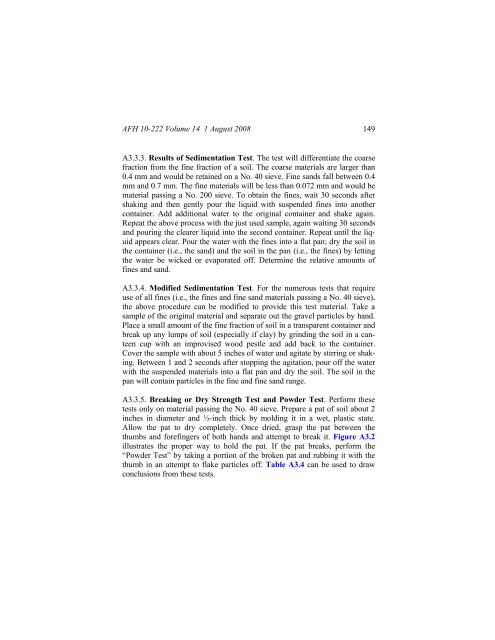Civil engineer guide to fighting positions, shelters, obstacles
Civil engineer guide to fighting positions, shelters, obstacles
Civil engineer guide to fighting positions, shelters, obstacles
You also want an ePaper? Increase the reach of your titles
YUMPU automatically turns print PDFs into web optimized ePapers that Google loves.
AFH 10-222 Volume 14 1 August 2008 149<br />
A3.3.3. Results of Sedimentation Test. The test will differentiate the coarse<br />
fraction from the fine fraction of a soil. The coarse materials are larger than<br />
0.4 mm and would be retained on a No. 40 sieve. Fine sands fall between 0.4<br />
mm and 0.7 mm. The fine materials will be less than 0.072 mm and would be<br />
material passing a No. 200 sieve. To obtain the fines, wait 30 seconds after<br />
shaking and then gently pour the liquid with suspended fines in<strong>to</strong> another<br />
container. Add additional water <strong>to</strong> the original container and shake again.<br />
Repeat the above process with the just used sample, again waiting 30 seconds<br />
and pouring the clearer liquid in<strong>to</strong> the second container. Repeat until the liquid<br />
appears clear. Pour the water with the fines in<strong>to</strong> a flat pan; dry the soil in<br />
the container (i.e., the sand) and the soil in the pan (i.e., the fines) by letting<br />
the water be wicked or evaporated off. Determine the relative amounts of<br />
fines and sand.<br />
A3.3.4. Modified Sedimentation Test. For the numerous tests that require<br />
use of all fines (i.e., the fines and fine sand materials passing a No. 40 sieve),<br />
the above procedure can be modified <strong>to</strong> provide this test material. Take a<br />
sample of the original material and separate out the gravel particles by hand.<br />
Place a small amount of the fine fraction of soil in a transparent container and<br />
break up any lumps of soil (especially if clay) by grinding the soil in a canteen<br />
cup with an improvised wood pestle and add back <strong>to</strong> the container.<br />
Cover the sample with about 5 inches of water and agitate by stirring or shaking.<br />
Between 1 and 2 seconds after s<strong>to</strong>pping the agitation, pour off the water<br />
with the suspended materials in<strong>to</strong> a flat pan and dry the soil. The soil in the<br />
pan will contain particles in the fine and fine sand range.<br />
A3.3.5. Breaking or Dry Strength Test and Powder Test. Perform these<br />
tests only on material passing the No. 40 sieve. Prepare a pat of soil about 2<br />
inches in diameter and ½-inch thick by molding it in a wet, plastic state.<br />
Allow the pat <strong>to</strong> dry completely. Once dried, grasp the pat between the<br />
thumbs and forefingers of both hands and attempt <strong>to</strong> break it. Figure A3.2<br />
illustrates the proper way <strong>to</strong> hold the pat. If the pat breaks, perform the<br />
“Powder Test” by taking a portion of the broken pat and rubbing it with the<br />
thumb in an attempt <strong>to</strong> flake particles off. Table A3.4 can be used <strong>to</strong> draw<br />
conclusions from these tests.
















